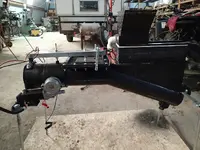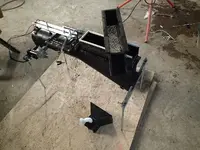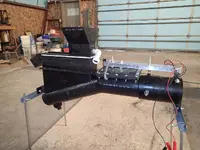Howdy Idaho Jim,
Thank you for the vid of your jig in action. So a form of trommel along with a pumped water source that of course can be recirced. I will caution you on the frog sound the machine makes especially if you use some yellow paint on the legs as the FS might just turn it into an endangered species.
Then again it might just be a comforting sound to listen to late at night just before falling to sleep, it might be a multi-purpose/use device. Cool invention! Keep up the thinking and tinkering!!
ABS plastic is a fairly strong material that can be easily vacuum heat formed into many shapes, vacuum forming is what it is called.
If the pump does not require much current, would it run off of a solar array? Solar energy kits can be had from Harbor Freight, or the last time I looked they had them.
What sort of classifying will your system need to function properly? I saw only sharp edged gravel and not much in the way of dirt so I assume that was just for test purposes but the unit will function on the classic dirt/gravel sample we are all used to working with.
Is the trommel planned as a permanent part of the jig or is hand feeding of the jig anticipated out in the field?
Where would the heavies be trapped in the jig?
Best of success with your jig unit......................63bkpkr
Yes...it can easily be hand-fed. It will also handle dirt just fine, though the water would get dirty really fast...too dirty to reuse. I like using the auto-feeder, assuming I can get my pickup close to where I'm working.
Now, on the location of concentrates in the jig...it depends. If going for gems only, you classify to two sizes +#8 to -#4, and +#4 to -#2. the reason for that is simple...gems only weigh about 50% more than the general gravel. If you try and run large and small together, you lose gems. The screen I use is about #10, so, since the gravel is roughly cleaned and classified to #8 it won't go through the screen, so it ends up on top of the screen, under the ragging (the general gravel).
If you're after both gold and gems, you still use self-ragging (the general gravel in the screen box), but since you're after gold, you are also letting all the small stuff go through the jig. The dirt has the same specific gravity as the rock, so it goes through the ragging, through the screen, and ends up in the hutch. You have to drain the hutch frequently under these operating conditions, or you end up with a bunch of packed mud in the bottom...not good. The gold under #10 mesh ends up in the hutch with the dirt....the gems and larger gold end up on top of the screen.
If going for gold or platinum only, you can use steel balls for ragging. Since steel is heavier than dirt, you don't get much mud in the hutch....just gold and black sand. Again, the gold larger than #10 ends up on top of the screen, under the steel shot...smaller gold and black sand in the hutch. You don't have to drain the hutch nearly as often, because there's much less dirt getting down there. If you want really clean cons, you can use lead shot as ragging...that's so heavy it gets rid of most of the black sand, but you will also lose a bit of the finer gold. Of course, using steel or lead as ragging means you won't recover any gems....they just go out with the rest of the waste material.
Jigs can be set up to do about anything you want. The general rules on the ragging go like this:
The larger the ragging material, the more cons you get, and vice-versa.
The heavier the ragging material, the fewer cons you get, and vice-versa
The thicker the ragging layer, the fewer cons you get " " "
The faster the water flow, the fewer cons
Pulse rate also has an effect, but it varies with the material you're after. This unit is a single speed at about 75CPM., which would work very well for fine gold. Finer, flatter gold takes longer to settle, because of it's shape, so you need a longer interval between pulses. That slower pulse rate has no negative effect on larger, coarser gold...it simply reduces the amount of material you can run per hour.
If I were using this jig, I'd put a two-lobed cam on it, to double the speed, than install a pulse-width-modulated speed control to have an adjustable 70-140 CPM unit. I just don't want to put any more time into it, as it is just a test prototype, and I'm selling it. It will work fine, as is.
As for running it on solar, I need to check the current draw of both the water pump, and drive motor to see how much current it actually uses. Then it could be determined how much solar panel is needed to do the job.
Jim









